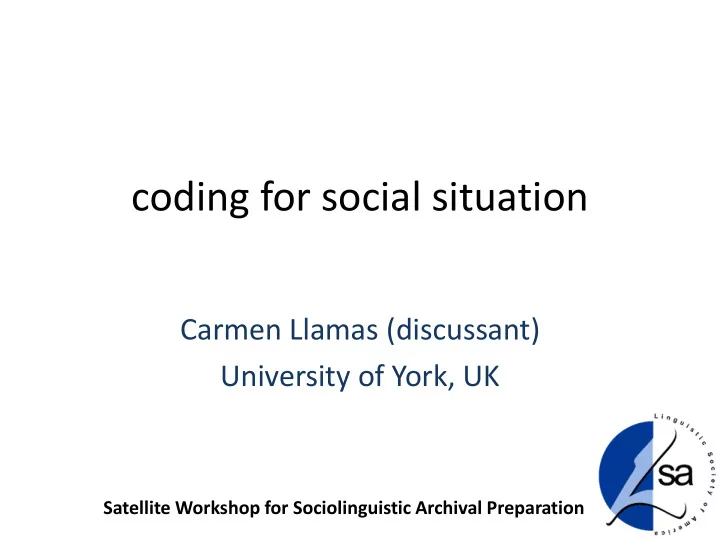

coding for social situation Carmen Llamas (discussant) University of York, UK Satellite Workshop for Sociolinguistic Archival Preparation
accommodation • context of dialects in contact -well established that speakers may adapt speech in response to varieties spoken by interlocutors • widely believed that accommodation processes are (or should be) central in explanation of language variation and change (Niedzielski & Giles, 1996) • how do we know when accommodation has taken place? (especially in one-shot interviews)
‘vernacular’ speech • suggestions of phonological convergence or divergence in interaction carry with them assumption that speaker is moving away from set of default production patterns – ascertaining what these are is neither a self-evident nor a trivial task • is the ‘vernacular’ an abstraction? • given the amount of intra-speaker variation we know speakers to exhibit, is there an envelope of variation we can allow for?
Eyemouth Eyemouth Berwick Berwick the context four Border communities: – Gretna (2,700) – Carlisle (101,000) – Eyemouth (3,400) Gretna Gretna – Berwick (26,000) Carlisle Carlisle • two studies: 1. effect of interviewer on interviewee (Llamas, Watt & Johnson 2009) 2. effect of interviewee on interviewer (Watt, Llamas & Johnson 2010)
the interviewer effect • ‘the idea that the researcher’s identity and ideological positioning vis-a-vis the interviewee crucially contribute to the patterning of data deserves more systematic exploration’ (Mendoza -Denton, 2002: 479)
the interviewer effect • 5 speakers in 3 separate interview contexts • all participants native speakers of BwE • 4 female (19, 38, 43, and 78), 1 male (17) • all interviewers female (20s or 30s) • IvS (South East of Scotland), IvE (North East of England), IvA non-native (Austrian) • IvA - neither of relevant ingroup/out-group associations that varieties of other two interviewers might evoke. Also paired interviews with IvA – constitutes a ‘control’ (closer to default production patterns) • interviews highlighted intergroup dimension where possible in order to influence informants’ definitions of situation as high in intergroup prominence
clear interviewer effect in read speech – monitoring of speech prompts convergence (attention to speech and audience design)
lettER - two of the five interviewees showed clear interviewer effect F1 of the lettER-class words over and border(s), in conversation with IvE (+) or IvS (×) for interviewees F38 and M17 (black markers indicate mean scores) reaction to the perceived identity/variety of the interviewer – not her actual linguistic behaviour
the interviewer effect • all speakers aware of upward convergence in certain situations • 3 speakers claimed would speak in a more ‘Scottish’ way to speakers of Scottish English (F38, F78, and M17) • only F38 and M17 (speakers who appeared to accommodate toward IvE) stated might alter speech with interlocutor NE of England
the interviewee effect • accommodatory strategies of female Scottish English-speaking fieldworker (25) in interactions with younger and older male speakers from localities on either side of the border • phonological, discoursal and lexical levels • Eyemouth ivees (2 older, 4 younger – all male) • Carlisle ivees (2 older, 4 younger – all male)
Frequencies (%) of tapped onset /r/, coda /r/, vocalized /l/, mouth monophthonging, and [e] in both-class words in the speech of the Scottish English-speaking interviewer and four informant groups in Eyemouth and Carlisle The size of data points represents sample size.
Frequencies (%) of f(r)ae ‘from,’ ken as a main verb, and ken in discourse marker constructions in the speech of the Scottish English-speaking interviewer and four informant groups in Eyemouth and Carlisle The size of data points represents sample size.
the interviewee effect • evidence for ‘overshoot’, maintenance and convergence • if forms stable and near categorical, then accommodation is unlikely • if forms unstable in community, then accommodation appears likely
additional factors to code for? • should (could)the interviewer record his/her conscious awareness of convergence toward the interviewee? (after listening back to recordings?) • should (could) the interviewee indicate what accent s/he perceives the interviewer to have? • should we indicate whether we think the interviewee was using the ‘vernacular’? How would we decide?
Recommend
More recommend